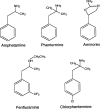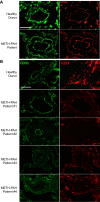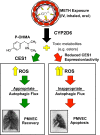Drug-induced pulmonary arterial hypertension: a primer for clinicians and scientists
- PMID: 29417823
- PMCID: PMC6032070
- DOI: 10.1152/ajplung.00553.2017
Drug-induced pulmonary arterial hypertension: a primer for clinicians and scientists
Abstract
Drug-induced pulmonary arterial hypertension (D-PAH) is a form of World Health Organization Group 1 pulmonary hypertension (PH) defined by severe small vessel loss and obstructive vasculopathy, which leads to progressive right heart failure and death. To date, 16 different compounds have been associated with D-PAH, including anorexigens, recreational stimulants, and more recently, several Food and Drug Administration-approved medications. Although the clinical manifestation, pathology, and hemodynamic profile of D-PAH are indistinguishable from other forms of pulmonary arterial hypertension, its clinical course can be unpredictable and to some degree dependent on removal of the offending agent. Because only a subset of individuals develop D-PAH, it is probable that genetic susceptibilities play a role in the pathogenesis, but the characterization of the genetic factors responsible for these susceptibilities remains rudimentary. Besides aggressive treatment with PH-specific therapies, the major challenge in the management of D-PAH remains the early identification of compounds capable of injuring the pulmonary circulation in susceptible individuals. The implementation of pharmacovigilance, precision medicine strategies, and global warning systems will help facilitate the identification of high-risk drugs and incentivize regulatory strategies to prevent further outbreaks of D-PAH. The goal for this review is to inform clinicians and scientists of the prevalence of D-PAH and to highlight the growing number of common drugs that have been associated with the disease.
Keywords: drug-induced pulmonary hypertension; pathology; pharmacovigilance; prevention.
Figures




Similar articles
-
Drug-Induced Pulmonary Hypertension: The First 50 Years.Adv Pulm Hypertens. 2017 Jan 1;15(3):133-137. doi: 10.21693/1933-088x-15.3.133. Adv Pulm Hypertens. 2017. PMID: 34306297 Free PMC article.
-
Treatment of children with pulmonary hypertension. Expert consensus statement on the diagnosis and treatment of paediatric pulmonary hypertension. The European Paediatric Pulmonary Vascular Disease Network, endorsed by ISHLT and DGPK.Heart. 2016 May;102 Suppl 2:ii67-85. doi: 10.1136/heartjnl-2015-309103. Heart. 2016. PMID: 27053700
-
Gender-related differences in pulmonary arterial hypertension targeted drugs administration.Pharmacol Res. 2016 Dec;114:103-109. doi: 10.1016/j.phrs.2016.10.018. Epub 2016 Oct 19. Pharmacol Res. 2016. PMID: 27771466 Review.
-
Novel strategies for treatment of pulmonary arterial hypertension.Postepy Hig Med Dosw (Online). 2017 Jul 11;71(0):577-588. doi: 10.5604/01.3001.0010.3838. Postepy Hig Med Dosw (Online). 2017. PMID: 28791952 Review.
-
Efficacy and Safety of Pulmonary Arterial Hypertension-specific Therapy in Pulmonary Arterial Hypertension: A Meta-analysis of Randomized Controlled Trials.Chest. 2016 Aug;150(2):353-66. doi: 10.1016/j.chest.2016.03.031. Epub 2016 Apr 2. Chest. 2016. PMID: 27048870
Cited by
-
Ion channels as convergence points in the pathology of pulmonary arterial hypertension.Biochem Soc Trans. 2021 Aug 27;49(4):1855-1865. doi: 10.1042/BST20210538. Biochem Soc Trans. 2021. PMID: 34346486 Free PMC article. Review.
-
Infection in pulmonary vascular diseases: Would another consortium really be the way to go?Glob Cardiol Sci Pract. 2019 Mar 31;2019(1):1. doi: 10.21542/gcsp.2019.1. Glob Cardiol Sci Pract. 2019. PMID: 31024943 Free PMC article. No abstract available.
-
Impact of Nutrition on Pulmonary Arterial Hypertension.Nutrients. 2020 Jan 7;12(1):169. doi: 10.3390/nu12010169. Nutrients. 2020. PMID: 31936113 Free PMC article. Review.
-
Trends and patterns in pulmonary arterial hypertension-associated hospital admissions among methamphetamine users: a decade-long study.Front Cardiovasc Med. 2024 Oct 28;11:1445193. doi: 10.3389/fcvm.2024.1445193. eCollection 2024. Front Cardiovasc Med. 2024. PMID: 39529971 Free PMC article.
-
Sex-dependent right ventricular hypertrophic gene changes after methamphetamine treatment in mice.Eur J Pharmacol. 2021 Jun 5;900:174066. doi: 10.1016/j.ejphar.2021.174066. Epub 2021 Mar 28. Eur J Pharmacol. 2021. PMID: 33789156 Free PMC article.
References
-
- Abenhaim L, Moride Y, Brenot F, Rich S, Benichou J, Kurz X, Higenbottam T, Oakley C, Wouters E, Aubier M, Simonneau G, Bégaud B; International Primary Pulmonary Hypertension Study Group . Appetite-suppressant drugs and the risk of primary pulmonary hypertension. N Engl J Med 335: 609–616, 1996. doi:10.1056/NEJM199608293350901. - DOI - PubMed
Publication types
MeSH terms
Substances
Grants and funding
LinkOut - more resources
Full Text Sources
Other Literature Sources
Medical

